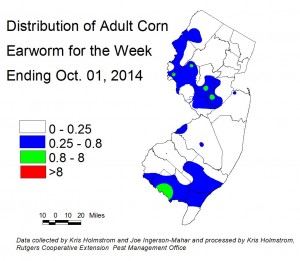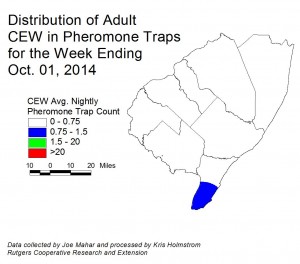Note: The backlight network is now being dismantled. Some traps will remain in operation for the next few weeks as crops continue. No maps will be produced for the remainder of the season, but pertinent pest information will be reported in subsequent weekly updates.
Topics for the Week
- Sweet Corn
- Tomatoes
- Pumpkins and Winter Squash
- Cole Crops
Maps for the Week
–Corn Earworm Moth Blacklight Trap Map
–Corn Earworm Moth Pheromone Trap MapVegetable IPM Report 10-1-14 – Click to View | Download | Print
Sweet Corn
European Corn Borer (ECB) ) adult activity is nearly nonexistent, with only a few traps capturing individual moths. The threat of ECB infestation is now past. The few remaining sweet corn plantings are almost all in the silk stage. Any lingering ECB larvae will be managed by sprays applied to manage corn earworm (CEW) and fall armyworm (FAW).
Corn Earworm Blacklight Trap: Corn earworm moth (CEW) activity is very low, with a few adults being captured when night temperatures approach 60°F. CEW moth activity is still higher in southwestern counties, although scattered catches remain as far north as Sussex County (see CEW blacklight map). At these levels, CEW are still capable of damage remaining sweet corn plantings if not controlled.
| The highest nightly CEW trap catches are as follows: | |||||
| Jones Island | 3 | Clinton | 1 | Little York | 1 |
| Belvidere | 1 | Eldora | 1 | Matawan | 1 |
| Cinnaminson | 1 | Folsom | 1 | Newton | 1 |
Pheromone Trap: CEW pheromone trap catches declined significantly over the past week. Remaining activity is still in Cape May County (see CEW pheromone trap map). The blue area on the map should be considered in the 5-day range. Low spots within the broader colored areas are outliers, and grower near those areas should defer to the more conservative schedule. The few sweet corn plantings still in silk in southern NJ should be treated to manage CEW.
| The highest nightly CEW pheromone trap catches are as follows: | |||||
| Green Creek 1 | Eldora 1 | ||||
Silking Spray Schedules*
South: 4-5 days
Central: 5 days
North: 5 days
*Note: These are general recommendations. Local trap catches may indicate some variation in the frequency of insecticide applications to silking corn.
Fall armyworm (FAW) infestations are ongoing throughout the state, although infestations are less severe, and slower to develop. It is important that all plantings be scouted regularly for this pest. FAW will also infest ears, although the silk spray schedule for CEW usually eliminates them from the plants at that time. Consider treating if the number of plants infested with FAW either alone, or in combination with ECB exceeds 12%. FAW may be difficult to control with pyrethroid insecticides. Newer materials, including spinosad-based insecticides, as well as those including active ingredients chlorantraniliprole and flubendiamide are effective against BAW.
Tomatoes
Late Blight: Dr. Andy Wyenandt reports that a new late blight infection was discovered on tomatoes in Cumberland County last Friday (9/26). See his post in the Plant and Pest Advisory for details. IPM personnel have discovered no infections on commercial fields in New Jersey. All growers with late season tomatoes should scout their fields several times a week. Growers should apply fungicides that specifically target late blight in addition to their normal protectant fungicide program, particularly in areas near the latest reported infection. For organic growers, fixed copper formulations should be applied preventively and at frequent, regular intervals to provide coverage to new growth. Individual plants showing late blight symptoms should be rogued.
Pumpkins and Winter Squash
Growers have discontinued fungicide applications on many pumpkin and winter squash fields, and have begun harvesting. For those later cucurbit fields, it is important to note that cucurbit downy mildew (CDM) is active on cucumbers in New Jersey. Recently, CDM has also been found on cantaloupe in Cumberland County. Reports from PA and NY indicate that DM is impacting cucumbers there. As of this Tuesday (9/30), IPM personnel have detected no other cucurbit crops with DM infections. However, given the virulence of CDM, it is advisable that pumpkin growers who are still applying fungicides to fields add products that specifically target CDM to their regular protectant program for powdery mildew (PM).
The CDM website http://cdm.ipmpipe.org/ indicates moderate risk of spread into New Jersey for the first part of this week. The latter half of this week will bring rain from the south. This may increase the chance of CDM infections by the weekend. It is important to note that other infection sites in neighboring states are cucumber infections. Heavy dew periods will cause existing field infections to worsen unless excellent coverage with proper fungicides is achieved. The CDM website should be a “favorite” on every grower’s web browser. It is advisable that all growers scout crops at least twice a week. Any further occurrence will be reported in this newsletter and will also generate an alert to all subscribers.
Cole Crops
The pest situation for cole crops remains unchanged. Diamondback moth (DBM) and imported cabbage worm (ICW) infestations are common. Scout plantings weekly. Check 5 consecutive plants each in 10 random locations throughout the planting, paying particular attention to the innermost leaves where ICW often feed. Consider treating if caterpillars are found on 10% or more plants that are in the 0-9 true leaf stage. From 9-leaf to the early head stage (in broccoli, cauliflower and cabbage) infestations up to 20% may be tolerated. Once heads begin to form, a 5% threshold should be observed to protect the marketable portion of the plant. For leafy greens such as collards and kale, 10% plants infested is the threshold throughout. It is important to identify DBM and BAW correctly, because if it present, synthetic pyrethroid insecticides may not provide acceptable control. DBM larvae are small, and taper toward both ends. They thrash vigorously when disturbed. BAW are green with a pale stripe down each side and a prominent dark spot on each side of the second segment behind the head.
Broccoli and collard plantings are developing crucifer downy mildew (CrDM) infections. CrDM caused necrotic spots to develop on the upper surface of older leaves. Inspection of the lower leaf surfaces will show pale purple sporulation erupting from the infected tissue. This disease can be especially hard on broccoli and collard greens, so growers should actively scout plantings at least weekly. Cole crops should be treated with appropriate fungicides at the first occurrence of this disease. Consult the 2014 Commercial Vegetable Production Recommendations for specific fungicide recommendations.
All current and archived Vegetable IPM Maps including European corn borer, corn earworm and brown marmorated stink bug population maps are available for viewing @ http://tinyurl.com/njaes-ipm-maps



